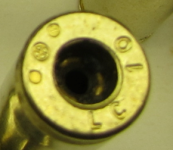Guffey and others think the countersink removes brass that holds the primer in. I think that is an erroneous assumption. No one is saying they have actually experienced, or measured it, or had primer pockets loosen for this reason (as opposed to HOT loads).
The crimp when made, is a distortion to the case head to intentionally spread brass around the primer, thus locking it in place and making it harder to remove, and the brass harder to reprime.
The solution we are discussing, using a countersink bit to remove the distorted brass, and a tiny bit more, to ensure the new primer can pass through into the primer pocket, has never been proven, demonstrated, measured, or quantified, to reduce the primer pockets ability to hold primers in place. It did not happen, because it does not happen.
A lot of people here are theorizing about what is the "right" or "wrong" way, or tool, to do something. They are imagining evils, that have not, in my experience, manifested in reality.
Now, I expect one of you will take your countersink bit, and drill, drill, drill baby, drill, until the primer won't stay in. I suspect that will happen at about the same time the point of the bit begins to enlarge the flash hole.
What has not happened in this thread is for anybody to speak factually about using this method, within reason, and having a provable complaint about the result. Not one. I know why. It is because the method works well, and DOES NOT cause primers to fall out. It works even better than swaging at making the primer pocket usable again. Yes I have touched up some professionally swaged primer pockets when I experienced primers "sticking" on the way in.
https://thefiringline.com/forums/attachment.php?attachmentid=96423&d=1409968327
This picture is an example of
probably the most brass I have removed where the crimp was. It looks like a lot of bevel, BUT, look at a commercial non-crimped case head, and specifically note that the primer cup has a significant rounded edge. Also, note the the brass the primer pocket is NOT a perfect cylinder. Removing a bit of brass at these rounded corners does not materially lessen the bearing surface which does actually hold the primer in (with no crimp). There is plenty of bearing surface in the primer pocket below that bevel. That is the part of the primer pocket that holds the primer in.
This is a snip of a photo on Brass Bombers website, 5.56 processed (swagged). The swaging tries to move the brass back where it started before crimping. Notice the annular ring present (distorted brass). I have purchased and received brass just like this, from GIBrass. In my experience, some primers will still "stick". That is when I grab the drill and remove that visible ring, leaving a slight cut bevel. I am not faulting Brass Bomber or any other merchant. I am only showing what I believe is the residual issue with swaged primer pockets. Remove all traces of that ring, and the issue is gone for ever.

